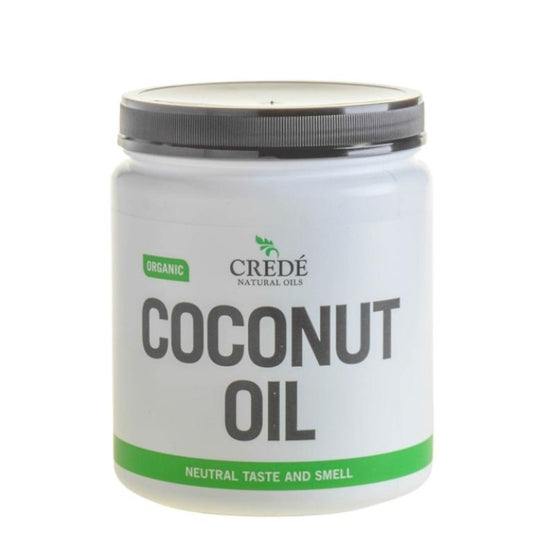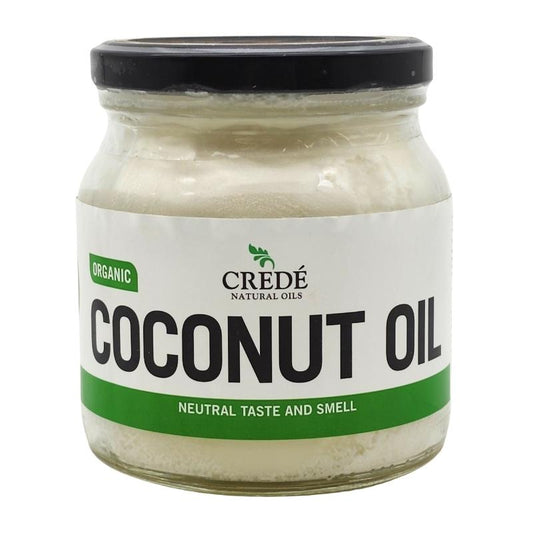
The Truth About Coconut Oil
Cayla MandeanIf you've ever landed on our deep-dive article about hair porosity and choosing the best oils for your hair type before, chances are you have already come across the endless buzz around coconut oil.
Or maybe it was a late-night Google search on how to grow longer, thicker hair… or a video promising Rapunzel-level results in 30 days. Either way, like many of us, you started researching oils, including castor, jojoba, argan, and, yes, coconut oil, which always seemed to make its way onto the list.
That's when things clicked. You realised coconut oil isn't just hype… It's a functional ingredient, and when used the right way (and on the right hair type), it can actually help retain moisture, nourish the hair follicle and strengthen the hair shaft, and add that shine you've been looking for.
But coconut oil's benefits don't stop at hair care. And it deserves a place in your bathroom cabinet and kitchen pantry too… in moderation.
Brief History of Coconut Oil
Coconut oil has been valued for centuries in regions like India, Southeast Asia, the Philippines, and the Pacific Islands. In Ayurveda and traditional Polynesian medicine, it was applied to wounds, used in hair care, and even ingested to aid digestion and immunity.
In recent decades, it's made a massive comeback, not just in natural health circles but in mainstream beauty and wellness. While not all traditional uses are fully backed by modern clinical research, emerging studies do point to some noteworthy benefits.
We'll be exploring these in more detail later in the blog.
What Is Coconut Oil?
Coconut oil is a plant-based oil derived from the white meat of mature coconuts, known for its unique composition of saturated fats, especially lauric acid, a medium-length, long-chain fatty acid that contributes to its antimicrobial, antifungal, and deeply moisturising properties.
There are two main types of coconut oil, each with distinct characteristics that make them better suited for different applications:
Virgin/ Unrefined Coconut Oil
Extraction: Made via cold-pressing or other minimal processing methods that preserve most of the natural compounds. It does not rely on heat or chemicals to extract the oil.
Appearance & Aroma: Retains its natural coconut aroma and flavour.
Nutrient Profile: Higher in polyphenols and antioxidants due to minimal processing.
Best For:
- Skincare: Ideal for dry skin, lips, and heels thanks to its emollient and nourishing properties.
- Haircare: Works well for thick, curly, medium to high porosity hair, or dry hair types.
- Oral care: Preferred for oil pulling due to its antimicrobial, antibacterial and antifungal effects and purity.
- Health and Wellness: It is rich in medium-chain triglycerides (MCTs), a type of fat that your body quickly absorbs for energy (should be consumed in moderation as it is a saturated fat), though its concentration is lower than that of isolated MCT oils, aka fractionated coconut oil and other vegetable oils.
- Light cooking: Suitable for sautéing or baking at moderate temperatures (smoke point ~around 177°C). The smoke point is the temperature at which the oil starts to break down and produce smoke, indicating it's overheating and losing nutritional value. Heating oils past their smoke point has been linked to harmful diseases and can also create an off, burnt flavour. Note: If you plan to cook at very high heat, you may still want to opt for other oils.
Refined Coconut Oil
Extraction: Made from dried coconut meat (also known as copra) and processed, refined, bleached, or deodorised to remove the scent.
Appearance & Aroma: Neutral taste and scent.
Nutrient Profile: Lower in certain antioxidants, but still retains beneficial fatty acids like lauric acid.
Best For:
- High-heat cooking: It is more heat-stable and great for frying and roasting due to its higher smoke point (approximately 204°C). Note: Although coconut oil is high in saturated fat, its unique structure may not carry the same risks as animal fats, but since its health effects remain debated, moderation and dietary balance are essential, particularly for those managing cholesterol or heart health.
- Sensitive noses or palates: Ideal when you want the benefits of coconut oil without the strong coconut flavour.
- DIY cosmetics: Works well in formulas where a neutral scent is desired.
Why Does Coconut Oil Go Solid in Cooler Temperatures?
Coconut oil becomes solid at room temperature because it is high in saturated fats, which have a relatively high melting point of around 76°F (24°C). Below this temperature, the fat molecules pack tightly together, causing the oil to solidify.
This is why coconut oil often appears as a solid or semi-solid in cooler environments but melts into a clear liquid when warmed. This natural change in state doesn't affect its quality or benefits; it's simply a physical property of the fats it contains.
But what if you don't want it to solidify?
Then, MCT oils, aka fractionated coconut oil, are your answer! It is made by removing its long-chain fatty acids of virgin coconut oil via hydrolysis and steam distillation. Due to this, it remains in liquid form despite the temperature.
While there are pros, one major drawback of this kind of oil is that the beneficial long-chain fatty acids, lauric acid, are removed.
Lauric acid is a long-chain saturated fat that is responsible for some of coconut oil's many health benefits, such as providing antibacterial properties and moisturising the skin. However, pure MCT oil often contains caprylic and capric acids, which may also have antimicrobial benefits, though different from lauric acid.
You may be asking… "Now, when should I use MCT oil vs Coconut Oil?"
Well, you can use coconut oil when you want deep nourishment, antimicrobial benefits from lauric acid, or are working with dry or textured hair/skin.
Choose MCT oil when you want a lighter, non-greasy, always-liquid oil for sensitive skin, cosmetic formulations, or fast metabolic energy.
A Functional Cosmetic Ingredient
Now that we've distinguished between the types of coconut oil, we can better understand why coconut oil is such a popular base in moisturisers, balms, and hair treatments. And how you can use it in your formulations and wellness routine to get the most out of it.
- Moisturising Properties: Some studies suggest that virgin coconut oil is effective in improving skin hydration and increasing skin lipid levels. It is great to apply as is, on areas such as your elbows, knees, and even lips.
- Barrier Repair: It helps restore the skin's protective barrier, reduces inflammation and improves skin hydration, which is crucial for people with eczema and atopic dermatitis. You can simply apply it to areas where you feel your skin needs that extra bit of love.
- Antimicrobial & Antifungal: Lauric acid exhibits strong antibacterial and antifungal activity, especially against Candida albicans, of course, dependent on concentration and application. With that said, it is also great for oil pulling, which we will touch on further in the article.
- Coconut oil is one of the few oils that has been demonstrated in studies to coat the hair shaft, preventing protein loss and breakage. You can simply use it as a pre-poo treatment to help reduce damage from grooming and washing. Another way you can use it is as a scalp treatment, which you can read more about here.
Comedogenic Rating: Coconut oil (virgin and refined) has a rating of 4 out of 5, meaning it can clog pores for certain skin types like acne-prone individuals, especially on the face. So, while it's a dream for dry feet and lips, be cautious with facial use unless your skin and scalp tolerate it. But what most people don't know is that fractionated coconut oil actually does not clog pores, as it is lightweight, perfect for almost all skin types.
Formulation Tips: In cosmetic formulations, it's typically used at concentrations of 5-30%, depending on the product type. Higher concentrations work well in balms and body butters, while lower percentages suit emulsions like lotions and conditioners.
How to Use Coconut Oil For Oil Pulling
One of the most buzzed-about uses of coconut oil is oil pulling, an ancient Ayurvedic practice where oil is swished in the mouth to remove toxins and improve oral hygiene, and indirectly, general wellness.
How To Oil Pull:
Take 1 tablespoon of virgin coconut oil.
Swish in your mouth for 10-20 minutes (don't swallow!).
Spit it into a trash bin (not the sink, as it can clog drains).
Rinse with water, then brush and follow your usual oral hygiene routine.
Benefits of Oil Pulling:
- Reduces harmful Streptococcus mutans bacteria.
- Some studies reveal how it helps fight plaque, bad breath, and reduces markers of oral inflammation.














1 comment
I also use it as a deep conditioning treatment about 1-3 times a month, my hair is naturally quite soft and healthy but this adds amazing shine! I’ve also replaced my night face cream with it, and use it as a deodorant (http://moslebd.com/
And it is a really good moisturizer over all 🙂 I also give my dog a scoop each day, she loves it and the oil is good for them, helps her dry skin! So many awesome uses!. I know there’s a way to make it out of dry shredded coconut, but it’s hard (and expensive!) to get a good quality shredded coconut.